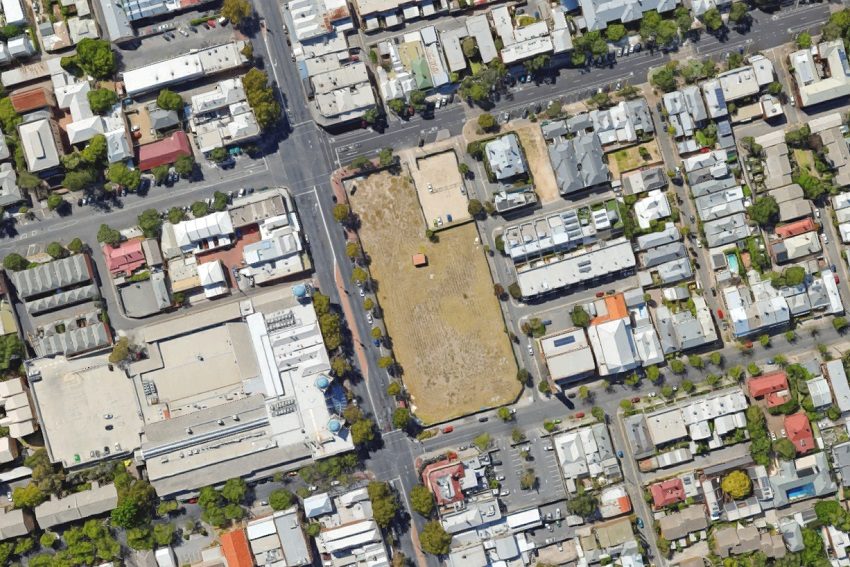Slings and Arrows: Will Le Cornu site forever stay a lost opportunity?

One of Adelaide’s many cultural features is that some people spend much of their time in the past, chasing proposals that never eventuated. The grassland behind a corrugated iron fence fronting North Adelaide’s O’Connell Street, commonly known as the former Le Cornu site, is a case in point.
Purchased in 2001 by the Makris Group, the old Le Cornu space is Adelaide’s most-known undeveloped building site, noted for grand plans announced many times. Con Makris is the fourth landowner since 1989, almost 30 years ago. He’s owned it for 16 years.
Let young feet run free?
In August last year a city councillor wearily noted that, once again, the deadline for building had once again passed, and called for more chats with Mr Makris, this time about leasing the land for a year “for community use”. While this idea appeared new, it wasn’t. In 2004, for example, one ageing North Adelaide resident, who had spent her childhood there but about 50 years interstate before returning, wrote to the Group suggesting that Mr Makris donate the land to the city.
“I understand that you wish to make the development of this site your legacy. However, I believe that turning the site into a park would provide a much greater legacy to the people of Adelaide, and one which would see the retention of the Makris name long after you returned to Greece, if it is correctly reported [in 2004] that you wish to do this,” she wrote. “O’Connell Street needs a park far more than it needs another cinema or supermarket. Your [shopping] centre opposite already has an excellent supermarket … A park would provide a place for families to gather, children to play, and for the children and staff of North Adelaide Primary School to use.”
‘Merit’
The 2004 response from then Makris Group GM, Ken Cooney, said that a park “to commemorate the Makris family and provide open space for the community has merit”. However, he cited other reasons that not only justified the need for commercial development in North Adelaide, but also impelled the Group to start building. “We have had community consultation with residents … who have endorsed the premise that a development would occur on this vacant land.”
He went on to say that in early 2005 big plans would be revealed. City council records of that time actually revealed that a number of locals had suggested turning the land into a community asset, rather than another shopping centre. One prominent city historian and economist, Dr Hugh Stretton, in 2005 suggested council compulsorily acquire the land for “public purpose”. Nothing came of it. Mr Cooney also wrote: “The cost to acquire the land makes it prohibitive to turn it into a park.”
The 2001 undeveloped cost was about $6m. Since then, the land value has risen, and in 2012, got a shot of real-estate dollars elephant juice when the state government declared that site open to exceptional development provisions, allowing unprecedented density and high rise. This government magic wand suddenly meant that land value now was so high that even if the Group decided against development and wanted to sell, the number of buyers willing to pay would be tiny. Maybe zero. In other words, in attempting to help the owner, the government actually created a gold-plated handicap that hampered flexible thinking about commercial disposal.
Mr Makris is often quoted as planning retirement, moving north, and even returning to Greece, despite his claimed love of South Australia. The park concept made sense in 2004, and still makes sense – but would require fresh thinking in light of what the government has done. North Adelaide has high-density residential zones and narrow streets, and a new park within them would introduce an asset of community value unequalled in city post-war history.
But something needs to give. Mr Makris is 70 this year. He could choose to look at the community needs of this part of Adelaide, and reflect on the cost of paying probably hundreds of thousands of dollars in land rates for 16 years with no result. Another 16 years? Or he could make a grand gesture, gift the land, stop writing rates cheques, and concentrate on his extensive property portfolio elsewhere. And, as the author of that 2004 letter said: “North Adelaide, and South Australia, would be forever in your debt.”
Ash Whitefly is Executive Director of the Adelaide Whitefly Institute of Diplomatic Studies.